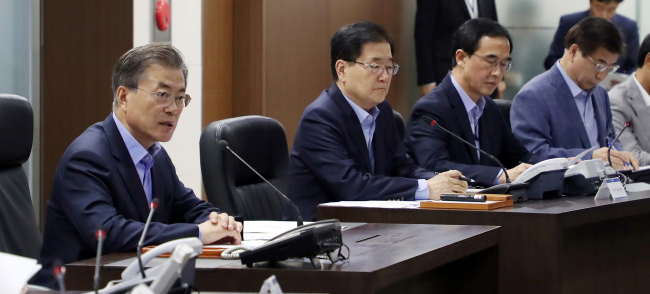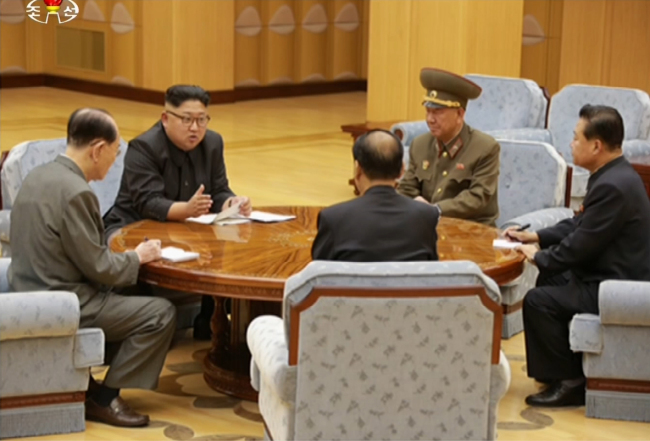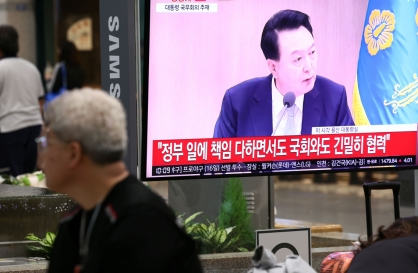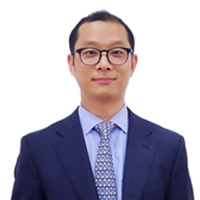North Korea claims successful H-bomb ICBM warhead test
Moon calls for means to achieve ‘complete and irreversible’ end to NK’s nuclear program
By Choi He-sukPublished : Sept. 3, 2017 - 20:25
North Korea on Sunday conducted its sixth nuclear test, claiming that it was now capable of producing intercontinental ballistic missiles fitted with thermonuclear warheads.
Pyongyang’s latest provocation came amid international condemnation and sanctions, applied even by its ally China. North Korea’s nuclear test was detected by South Korean, Chinese and other authorities, at about 12:29 p.m.
Pyongyang’s latest provocation came amid international condemnation and sanctions, applied even by its ally China. North Korea’s nuclear test was detected by South Korean, Chinese and other authorities, at about 12:29 p.m.

In a “critical announcement” at 3:30 p.m., North Korea’s state media claimed that the test was a “complete success of a hydrogen warhead for an ICBM.”
Sunday’s nuclear test took place hours after North Korea claimed that it had completed its thermonuclear technologies and was now capable of producing “powerful nuclear weapons at will.”
South Korea’s President Moon Jae-in convened a National Security Council meeting at 1:30 p.m., where he called for all possible means to put an end to the North’s nuclear program.
“The provocation is not only a clear violation of UN Security Council resolutions, but also a very grave challenge to international peace and security (that I) strongly condemn,” Moon said at the meeting.
Adding that Pyongyang had made an “absurd tactical mistake” that further isolates itself, Moon said that Seoul would seek punitive measures in cooperation with the international community.
“Diplomatic and security ministries should work with the international community to draw up measures to prompt North Korea to give up its nuclear missile program in a complete, verifiable and irreversible manner.”
Saying that his government would not tolerate further advances in North Korea’s missile and nuclear weapons technologies, Moon called for heightened military readiness.
Moon’s top national security adviser Chung Eui-yong also had a telephone conversation with his US counterpart Herbert McMaster, Cheong Wa Dae said.
Seoul’s Joint Chiefs of Staff Chairman Gen. Jeong Kyeong-doo also sought close cooperation with the US military, saying that an “effective military response” is required as soon as possible in the conversation with US JCS Chairman Gen. Joseph Dunford.
According to the South Korean JCS, Dunford echoed Jeong’s views and promised full support for Seoul’s response and to make joint efforts on the level of the South Korea-US alliance.
Meanwhile, China’s Foreign Ministry urged the regime to stop “wrong actions that only deteriorate the situation,” while Japanese Prime Minister Shinzo Abe called it “absolutely unacceptable.”

According to Seoul’s JCS, seismic waves measuring magnitude 5.7 were detected from Punggye-ri, North Hamgyong Province in the northeastern region of North Korea, at 12:29 p.m. Punggye-ri is the site of Pyongyang’s previous nuclear tests.
Those readings would put the size of the explosion at several times larger than previous North Korean tests. It could be much larger still if the reading of 6.3 magnitude by the United States Geological Survey is correct. The Chinese government also put the size of the tremor at magnitude 6.3.
Moon, who had called for dialogue with North Korea during his election campaign, has been pushed to take an increasingly harder stance following the series of provocations.

Following North Korea’s missile launch in July, Moon ordered for more THAAD launchers to be deployed in Seongju, North Gyeongsang Province. After a North Korean missile flew over Japan’s airspace to land in the Pacific on Aug. 29, Moon ordered the military to conduct a show-of-force exercise.
Under the Moon administration, Seoul has also renewed the push to increase its missile capabilities, which are limited under missile guidelines with the US. In the latest move, Seoul seeks to raise the maximum payload of locally developed ballistic missiles to 1 ton from the current 500 kilograms.
According to Cheong Wa Dae, US President Donald Trump “agreed in principle” to allow the changes sought by Seoul.
While Moon’s approach to North Korea hardens, talks of bringing US’ tactical nuclear weapons back to South Korea have reemerged, which is a move that has long been championed by conservatives.
North Korea’s increasingly serious provocations have prompted the current liberal administration’s Minister of National Defense Song Young-moo to discuss the issue with his US counterpart.
By Choi He-suk (cheesuk@heraldcorp.com)







![[From the Scene] Monks, Buddhists hail return of remains of Buddhas](http://res.heraldm.com/phpwas/restmb_idxmake.php?idx=644&simg=/content/image/2024/04/19/20240419050617_0.jpg&u=20240419175937)








![[From the Scene] Monks, Buddhists hail return of remains of Buddhas](http://res.heraldm.com/phpwas/restmb_idxmake.php?idx=652&simg=/content/image/2024/04/19/20240419050617_0.jpg&u=20240419175937)

![[KH Explains] Hyundai's full hybrid edge to pay off amid slow transition to pure EVs](http://res.heraldm.com/phpwas/restmb_idxmake.php?idx=652&simg=/content/image/2024/04/18/20240418050645_0.jpg&u=20240419100350)

![[Today’s K-pop] Illit drops debut single remix](http://res.heraldm.com/phpwas/restmb_idxmake.php?idx=642&simg=/content/image/2024/04/19/20240419050612_0.jpg&u=)